
View of the ancient houses of Machu Picchu, Urubamba Province, Cusco Region, Peru, 30 July 2015, photo by Diego Delso, delso.photo, License CC-BY-SA.
The Committee for Cultural Policy[i] and Global Heritage Alliance[ii] jointly submitted testimony on September 26, 2021 to the Cultural Property Advisory Committee (CPAC), at the Bureau of Educational and Cultural Affairs, U.S. Department of State, on the extension of the Proposed Memorandum of Understanding (MOU) and the continuing imposition of import restrictions between the United States and the Republic of Peru. These import restrictions prohibiting entry to the United States of Peruvian ancient and ethnographic art began in 1997, and have been renewed (and often expanded) every five years since then. A hearing on the request was held on October 2, 2021.
Summary of Peruvian Law
Every claim by Peruvian authorities made in the U.S. recites that restitution is required under Peruvian law (and so, surprisingly, do the announcements of seizures by Homeland Security Investigations) despite the lack of jurisdiction of such foreign law in the U.S. Yet both the history of Peru’s laws and the history of their enforcement points to a more limited range of items to which Peruvian law has applied at various times. There have also been lengthy periods when laws against export were largely ignored by Peruvian authorities. Finally, Peruvian law continues to allow private collecting within Peru together with, more recently, policies encouraging the establishment of private museums, raising questions about whether Peru is taking the steps to halt looting and archaeological destruction required under the self-help provisions of the 1983 Cultural Property Implementation Act (CPIA), the U.S. legislation that defines when import restrictions can be used.
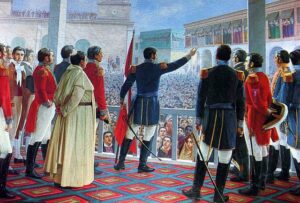
Peru often asserts that national ownership dates to 1822. Proclamation of the Independence of Peru on July 28, 1821, 1904, Juan Lepiani (1864-1933), National Museum of Archaeology, Anthropology, and History of Peru, Wikimedia Commons.
Even under colonial rule, Spain indirectly framed its right to exploitation of mineral wealth within the concept of ownership of treasure.[iii] In 1822, within a year of independence from Spain, the new Peruvian government declared itself the owner of all pre-Hispanic monuments, created a museum (which was not built until much later) and prohibited all excavations – which nonetheless continued apace.[iv] Removal of ancient objects and “treasure” continued and “The predominant view until the end of the 19th century was to see the protection of cultural heritage as a second-order topic or even an obstacle to the modernization of the Nation.”[v] The arrival of foreign archaeologists, most notably Hiram Bingham, the re-discoverer of Machu Picchu, prompted a series of decrees permitting and then disallowing export. The Peruvian Constitution of 1933 contained the first specific reference to cultural heritage and referenced a category of objects deemed “treasures.”[vi]
In 1939, another law “granted a special protection to objects and monuments with historical value from the colonial period.”[vii] It was not until issuance of Peru’s Constitution of 1979 that Peru’s government firmly established and broadened the concepts of both tangible and intangible heritage:
“The deposits and archeological sites, buildings, monuments, artistic objects and testimonies with historical value, which have been declared Cultural Heritage of the Nation, are under the protection of the State. The law regulates their conservation, restoration, maintenance and restitution.”[viii]
Peru’s most recent Constitution of 1993 and the Law N° 28296 (General Law of the Cultural Heritage of the Nation) have opened up the prior State ownership concept to acknowledge that there is valid private ownership of Peru’s cultural heritage. They have also promoted private involvement in developing museums, conservation and restoration of heritage. At the same time, official registries were created to document archaeological and ecclesiastical cultural property.
No Request from Peru – Not even a Summary of the Request Has Been Published
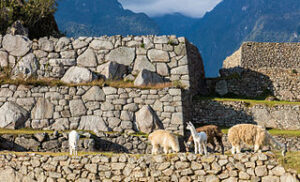
Machu Picchu, 30 July 2015, photo by Diego Delso, delso.photo, License CC-BY-SA.
CCP and GHA are hampered in our ability to fully respond to the request from the Republic of Peru due to the failure of the Department of State to include any documentation establishing the State Party’s continuing qualification for import restrictions.
There is no public information available from Peru to inform the U.S. public regarding how well or how poorly Peru is performing the various tasks of excavation of sites and preservation of monuments or the conservation and recording[ix] of the national heritage that its own law requires. There has been no data supplied on looting, although prominent Peruvian archaeologist Luis Jaime Castillo has recently stated that, “Here in Latin America and in many parts of the developing world, looting is not anymore the issue… Today, the biggest problem we have is land encroachment and land trafficking.” (See below) Nor is there information on any loan exhibitions from Peru that would enable the U.S. public, including almost the 700,000 U.S. residents who self-identify as of Peruvian origin,[x] to appreciate its magnificent cultural heritage.
Public comment is a necessary component of the regulatory process – but it can only be made if the public knows the scope of the request. Peru’s request was not published. CPAC’s administrators put only a one sentence summary on the Bureau of Educational and Cultural Affairs (ECA) website announcing the renewal request on September 16, only 10 days prior to the due date for comments:
“The Government of Peru has requested updates to the Designated List consisting of additional categories of archaeological material, including styles of ceramics and textiles, and ethnological material, including furniture, numismatic material, and prints.”
Peru’s Request is Contrary to the Statute and Congressional Intent

Lima Peru- tourist market- painting of Saint Martin de Porres, photo by Thayne Tuason, 11 October 2019, CCA 4.0 International license.
All we know from this is that the request for import restrictions will have even more restrictions than the last Designated List from Peru. Peru’s Designated List of five years ago was already extraordinarily broad. Yet such blanket restrictions on objects that are neither currently threatened by looting nor demonstrated to be illicitly trafficked in the U.S. were never contemplated by Congress, either in text of the CPIA or in the Congressional hearings on it.
“…On their face, wall-to-wall embargoes fly in the face of Congress’ intent.[xi] Congress spoke of archeological objects as limited to “a narrow range of objects…”[xii] Import controls would be applied to “objects of significantly rare archeological stature…As for ethnological objects, the Senate Committee said it did not intend import controls to extend to trinkets or to other objects that are common or repetitive or essentially alike in material, design, color or other outstanding characteristics with other objects of the same type…[xiii]”
There are also strict limitations on what types of artifacts may be restricted. In particular, import restrictions may only be applied to archaeological and ethnological artifacts of “cultural significance” “first discovered within” and “subject to the export control” of a specific UNESCO State Party.[xiv] They must be part of a “concerted international response” of other market nations, and can only be applied after “self-help” measures are tried.[xv] They must also be consistent with the general interest of the international community in the interchange of cultural property among nations for scientific, cultural, and educational purposes.[xvi]
The definitions of “archaeological” and “ethnological” objects in the statute limit the scope of any restrictions. Section 2601 defines them as follows:
(2) The term ―archaeological or ethnological material of the State Party means –
(A) any object of archaeological interest;
(B) any object of ethnological interest; or
(C) any fragment or part of any object referred to in subparagraph (A) or (B); which was first discovered within, and is subject to export control by, the State Party. For purposes of this paragraph—
(i) no object may be considered to be an object of archaeological interest unless such object –
(I) is of cultural significance;
(II) is at least two hundred and fifty years old; and
(III) was normally discovered as a result of scientific excavation, clandestine or accidental digging, or exploration on land or underwater; and
(ii) no object may be considered to be an object of ethnological interest unless such object is –
(I) the product of a tribal or nonindustrial society, and
(II) important to the cultural heritage of a people because of its distinctive characteristics, comparative rarity, or its contribution to the knowledge of the origins, development, or history of that people.

Virgin Mary Spinning, circa 1700, Denver Art Museum, public domain, Wikimedia Commons.
The legislative history underscores the fact that “ethnological material” is to be defined narrowly. As defined by Congress, ecclesiastical materials and Catholic paintings do not qualify for import restrictions under the law. According to the Senate Report,
““Ethnological material” includes any object that is the product of a tribal or similar society, and is important to the cultural heritage of a people because of its distinctive characteristics, its comparative rarity, or its contribution to the knowledge of their origins, development or history. While these materials do not lend themselves to arbitrary age thresholds, the committee intends this definition, to encompass only what is sometimes termed “primitive” or “tribal” art, such as masks, idols, or totem poles, produced by tribal societies in Africa and South America. Such objects must be important to a cultural heritage by possessing characteristics which distinguish them from other objects in the same category providing particular insights into the origins and history of a people. The committee does not intend the definition of ethnological materials under this title to apply to trinkets and other objects that are common or repetitive or essentially alike in material design, color, or other outstanding characteristics with other objects of the same type, or which have relatively little value for understanding the origins or history of a particular people or society.” U.S. SENATE REPORT, 97-564 at 5.
Of course, if an archaeological or ethnological object is stolen from the inventory of a museum or religious or secular public monument or similar institution, it would be returned to Peru under a separate provision of the CPIA and no listing on the Designated List is appropriate or required.[xvii]
Moreover, CPAC should take care that any import restrictions are only applied prospectively to items on the designated list illicitly exported from Peru after the effective date of governing regulations.[xviii] Unfortunately, U.S. Customs and Border Patrol (CBP) instead applies import restrictions far more broadly to any cultural goods imported into the United States after the effective date of import restrictions, i.e., Customs treats MOUs as embargoes, not targeted, prospective import restrictions.
Coins from Peru Fail to Meet Statutory Qualifications
The State Department announcement made on September 16 references “numismatic material” to be included in the Peru import restrictions.
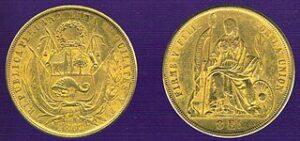
Gold coin of 8 escudos from Peru, 1863. Wikimedia Commons.
Coins are amongst the most common antique items in global circulation from any country. Coins from South American countries are from the Colonial era. They are not “ethnographic”; they are made by sophisticated industrial processes, not manually. Due to their widespread circulation in international commerce, one cannot assume such coins were “first discovered within” and hence were “subject to export control by” Peruvian authorities. Coins were minted in Peru with the intent that they circulate beyond its borders.[xix] In respect to coins, the Committee for Cultural Policy defers to numismatic experts and recommends reading the submission on behalf of the International Association of Professional Numismatists and the Professional Numismatists Guild, which have contributed a commentary covering the facts of the distribution of the coin types variously made and found in Peru, and the circulation of Peruvian coins in international commerce.[xx]
(1) All restricted cultural patrimony must be threatened by pillage. Peru has failed to even attempt to demonstrate that the objects in the Designated List are in jeopardy of pillage.
There is no evidence showing that all the objects on the designated list are threatened by pillage. The Government of Peru and Department of State have provided no information demonstrating that the entire range of archaeological and ethnographic materials in the Designated List are in jeopardy. The current MOU is not only overbroad, it is virtually all-inclusive.
(2) The self-help requirement – Peru has not taken sufficient measures to protect its cultural patrimony.

Chan Chan Archaeological Zone, trash being dumped, photo by Thayne Tuason, 25 September 2019, CCA 4.0 International license.
Destruction of archaeological sites is primarily caused by rampant development that the Peruvian government has failed to deter. The government underfunds and understaffs its cultural authorities. Peruvian archaeologists and conservationists are given little support and cannot compete with corporate development in the cities and corrupt political interests in the countryside. The government has failed to enforce Peruvian domestic laws that require protection of sites against corporations and wealthy builders and has not enforced archaeological protections in government road and infrastructure development.
Thus, while clandestine looting for sale to outsiders was a problem 40-80 years before in Peru, archaeological site destruction continues today for an entirely different reason: open, daylight destruction for the purpose of commercial and industrial development.[xxi]. There are an estimated 46,000 pre-colonial sites in Peru and about 400 in Lima alone. Peru’s government spends enough to protect just 1% of them.[xxii] One woman whose mother built their family home adjacent to a pyramid complex 35 years ago told a reporter that her family wants to care for the ancient site, but “Most people do not know how dangerous it is to care for a huaca. You have to face land traffickers, thieves and bad people. The worst part is that the state never recognizes or thanks you.”[xxiii]
According to a 2020 presentation by Luis Jaime Castillo, pre-eminent archaeologist and former Minister of Culture in Peru:
“Here in Latin America and in many parts of the developing world, looting is not anymore the issue. That’s not the issue. It might have been in the nineteenth century and in the early twentieth century. Today, the biggest problem we have is land encroachment and land trafficking. The development of cities and the new technologies used for agriculture are finally stepping into territories, sites, that had never been affected before. That is ninety-nine percent of our issues regarding our archaeological heritage. One percent is looting. One percent. Now, instead of destroying one burial, or two or twenty, we are destroying entire sites. A bulldozer is coming in and bulldozing tens of hectares and developing that into agricultural land or developing that into cities.
“Those are the real issues that we are facing. Now, there is a concomitant here, of course, because one of the ways to vacate the land is by first looting it, and then sending in the bulldozer. This is an issue that is actually, for us, more critical. The Ministry of Culture in Peru has a department that is involved in the protection of cultural heritage. In the past, when we had to face looters, we had to face, basically, a peasant with a shovel. Today, we have to face lawyers. Basically, a bunch of lawyers who are going to protect, with all the legal schemes that you could imagine, people who encroach and take over land.
“If you have one hectare of land, that is ten thousand square meters, if each meter is worth ten dollars, you have a hundred thousand dollars there of wealth. If it’s a hundred dollars per square meter, you are facing one million dollars. Here in Peru, for one million dollars, people kill you. Those are the issues that we are facing. I would combine them, because they come side by side. Because it is an [inaudible] situation, we have to adapt to how these things change in different settings and different moments.”[xxiv]
To give an example of failure to protect non-urban sites from illegal development, squatters at the 5,000 year old Caral archaeological site have threatened a famous archaeologist and her lawyer with death – and killed the archaeologist’s dog as a warning. Renowned archaeologist Ruth Shady said there were nine invasions from squatters at the Americas’ most ancient city during the pandemic, but the police have done nothing to drive them off. The price of land near the site has risen by ten times since its discovery. The squatters assert that the land was given to their family during a land reform program for farmers during the 1970s.[xxv]
This raises the question, “What is happening to the objects currently being looted from sites?”

Cidade Sagrada de Caral, Supe – Peru, photo by Paulo JC Nogueira, 24 October 2014, CCA-SA 3.0 Unported license.
Interviewees knowledgeable about the Peruvian market explained that hundreds of smaller to very large private collections have been built in recent decades in Peru and that these absorb the most valuable ancient materials that are found. The government of Peru now allows private collecting and encourages the creation of private museums, which are rapidly increasing in number.[xxvi] In Peru, collecting ancient objects is viewed as celebrating one’s national heritage and history. The looting taking place today is primarily opportunistic, occurring as a result of institutional weakness and lack of funding for heritage in general, and because “Peru’s long history of corruption entrenched in the same government has made it impossible to put into practice certain laws that could be beneficial for the defense and criminalization of the destruction of cultural heritage.”[xxvii] The lack of supervision of sites and the allowing of domestic trade,[xxviii] and the active competition to build collections of important ‘national works’ in the domestic market exacerbate the situation.
The decades of legal restrictions, the growth of an active domestic Peruvian market and, not least, the aging U.S. collector demographic means that the supply of Peruvian antiquities in the U.S. already far outstrips demand. According to interviews with U.S. art dealers and private collectors, there is no U.S. market for unprovenanced antiquities and no need to source antiquities except from existing long-held collections. The market for pre-Columbian objects, notably ceramics and textiles, was at its height in the 1970s, 1980s and early 1990s. As collectors have aged or died and collections have gone back on the market, there is a surplus of material available and far fewer buyers for it. The few buyers for important works demand both credible documentation and a legal warranty of good title from the seller. A serious collector interviewed for this submission explained that he has only purchased one item in the last ten years, and that object had a lengthy provenance from an older, well-known U.S. collection. One well-known dealer we interviewed confirmed that only well-provenanced items can be sold and that these are readily available from collections built in the 1950s to the 1980s. Another gallerist stated that he expects to have periodic visits from U.S. authorities tasked by the Peruvian consulates and ensures that he has paperwork on hand with documentation for all items in his inventory.
Of course, there are a significant number of minor items without documentation that continue to circulate in the U.S., forming a lower tier market of items from $25 to a few hundred dollars. When they surface from old collections, they are sold on Craig’s List or with other antiques in garage sales and flea markets. Even without legal restrictions on import, there is no financial incentive to bring Peruvian objects into the U.S., when so many low cost items are available, and no reason to smuggle them out of Peru, when its domestic market is far more eager and active.
(3) U.S. import restrictions may be implemented only if applied in concert with similar restrictions implemented, or to be implemented within a reasonable period of time, by nations with a significant import trade in the designated objects, would be of substantial benefit in deterring a serious situation of pillage, or establish that other, less drastic remedies are not available.

Aerial view of one of the geoglyphs of the Nazca Lines, which are located in the Nazca Desert in southern Peru. The
geoglyphs of this UNESCO World Heritage Site (since 1994) are spread over a 80 km (50 mi) plateau between the towns of
Nazca and Palpa, between 500 B.C. and 500 A.D. old. Author Diego Delso, delso.photo, 29 July 2015, License CC-BY-SA.
Image has been cropped. Contact diego@delso.photo
In the last two decades, Peru has signed agreements regarding the conservation, protection and return of stolen cultural objects with the Republic of Argentina (2001), Republic of Paraguay (2001), Republic of Chile (2002), Dominican Republic (2003 and 2011), Republic of Honduras (2007), Republic of Guatemala (2004), the Oriental Republic of Uruguay (1981 and 2002), United Mexican States (2002), Republic of Panama (2002), Republic of Ecuador (1997), Republic of Bolivia (1998), Republic of Nicaragua (2004), Republic of Costa Rica (2003), Federal Republic of Brazil (1996), Republic of Colombia (2002), Bolivarian Republic of Venezuela (2011), and Republic of El Salvador (2002).
Outside of South and Central America, Peru has signed bilateral treaties on cultural heritage with the Government of the Arab Republic of Egypt for return of stolen objects (2005), the Government of the People’s Republic of China (2000) and Morocco (2011). There is an agreement with Japan for the conservation of the archaeological sanctuary of Pachacamac and development of its local museum. Given the number of such treaties and agreements, one wonders whether – if looting continues – they are the most effective means of halting it and if other less drastic means cannot be found.
Peru’s diplomatic staff are active in many countries and are said to have recovered altogether 1700 objects of cultural heritage from Argentina, Australia, Colombia, Ecuador, the USA, the Netherlands, the United Kingdom, Sweden and Switzerland, up to 2018.[xxix]
The U.S. market has not triggered a current “serious situation of pillage.” According to recent interviews with U.S. gallerists there is not a market in the U.S. for pre-Columbian pottery unless it has several decades of verifiable provenance. In part this is because auction houses and galleries offering Peruvian objects for sale regularly receive letters from the U.S. consulates alleging that all objects are illicit, and citing to prior CPAC agreements regardless of the origin of the objects (all are deemed owned by the State) and sometimes to Peruvian claims of national ownership dating to 1822.[xxx] These letters are often followed by visits from the FBI or HSI, both of which are delegated responsibility to act for foreign governments through Mutual Legal Assistance Treaties.

Llama Vessel, Earthenware with colored slips, Peru, North Coast, Moche style (50-800), Cleveland Museum of
Art, John L. Severance Fund, https://clevelandart.org/art/1990.128
There are only a few sales recorded in the online catalogs from Sotheby’s or Christie’s U.S. locations for sales of ancient objects from Peru in the last decade; the vast majority of major auction sales have taken place in the UK or France. The only recent U.S. sales of Peruvian art noted were nine ecclesiastical paintings from Argentinian and other foreign collections in a single 2018 sale of Latin American paintings at Christie’s and sales of modern coins. The most recent Christie’s sale of pre-Columbian pottery objects was in a low value “house sale” on June 19, 2006, fifteen years ago. Sotheby’s appears to have ended its sales of Peruvian artworks except modern paintings in 2011.
The vast majority of items resulting from any search of “Peru” items for sale at auction are books, lithographs, prints and paintings dating to 150 years old or less. Under no circumstances can books, lithographs, prints and paintings dating to 150 years old or less be deemed “ethnographic” items under the statute or described as “pillaged” yet the Peruvian request also seeks to ban these from import into the U.S.
(4) The request does not meet the criteria that the application of the import restrictions is consistent with the general interest of the international community in the interchange of cultural property.
Historically, the question of the general interest in the interchange of cultural property has been dealt with by CPAC by counting the number of museum exhibitions and loans to the United States. While this kind of an answer actually does not address the question of how the “general interest of the international community” can or should be defined, it at least establishes a sort of yardstick for relative access.
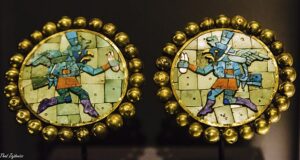
A pair of ear ornaments from Peru (Moche), ca. AD 200-600, Gold; shell; stone, photo by Thad Zajdowicz, 28 September 2017, J Paul Getty Museum, Los Angeles, California, CC0 1.0 Universal Public Domain Dedication.
Since Peru very rarely loans objects for foreign exhibitions, museum shows of important U.S. collections of Peruvian art have been the primary means for the U.S. public to access it. Examples of such extraordinary collections include the Robert Woods Bliss collection at Dumbarton Oaks (collected between 1947 and 1962), the Jan Mitchell and Sons Collection of Peruvian gold objects at the Metropolitan Museum in New York donated in the 1990s, and the Alice K. Bache (1903-1977) collection at the Metropolitan Museum, donated in the 1960s and 1970s.
CCP was unable to locate a single traveling exhibition from Peru to the U.S. during the last five years of the U.S.-Peruvian MOU. The Peruvian request fails to demonstrate that Peru has undertaken to make its cultural heritage available to the U.S. or the global public.
Conclusion
When Congress passed the Cultural Property Implementation Act in 1983, it placed procedural and substantive constraints on the executive authority to impose import controls. Under the aegis of the State Department’s Bureau of Educational and Cultural Affairs, import restrictions under the CPIA have provided for near permanent bans on the import of virtually all cultural items from the prehistoric to the present time from the countries which have sought agreements. If CPAC fails to heed the concerns of Congress regarding overbroad import restrictions – without providing evidence that the requesting countries meet the four determinations, CPAC not only acts in derogation of U.S. law, but also lends support to an exclusively statist rather than internationalist policy on cultural heritage.
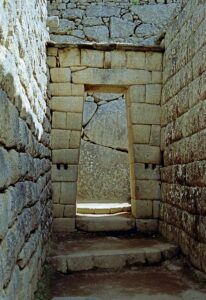
Machu Picchu, so-called Royal Residence with private garden, sentry house and bathroom. Machu Picchu, Peru, photo by Dennis Jarvis from Halifax, Canada, 23 April 2007,
https://www.flickr.com/people/22490717@N02, CCA-SA 2.0 Generic license.
Import restrictions for any specific country under the Cultural Property Implementation Act were never intended to be a permanent fixture of the United States’ customs laws. The Act instead recognizes the benefits of temporary import restrictions to ameliorate a serious problem of pillage in particular types and periods of objects. Thus, Congress held import restrictions to a limited 5-year renewable basis under the CPIA. This limited time period was considered appropriate as a tradeoff, temporarily restricting access by U.S. museums and the public to artifact types from sites in serious threat of destruction. The limited 5-year time frame was intended to give source countries the opportunity to build their own enforcement capacities to halt looting, pass legislation, build museums and institutions, document inventories and take other measures to safeguard antiquities, and to educate its public to appreciate the social benefits of preserving and honoring its past. Import restrictions in Peru have been far more comprehensive than justified under the law for over a decade. If 24 years of import restrictions since 1997 are not sufficient to solve a problem, the restrictions cannot reasonably be deemed an appropriate solution.
The Cultural Property Advisory Committee cannot legitimately find that the MOU continues to be necessary or appropriate when the most distinguished Peruvian archaeologist has stated that development is the cause of 99% of the destruction and only 1% is looting.[xxxi] We do not believe that renewing the MOU will help, since the Peruvian experiment has run its course for twenty-four years. Other means of assisting Peruvian cultural development and helping to support its many learned academics and hardworking archaeologists should be found – such as rewards to finders like those implemented in Britain’s Portable Antiquities Scheme. All renewing this MOU will accomplish is to damage America’s public interest in the circulation of art.
When the CPIA was passed, its goal was to facilitate a lawful trade that enriched U.S. cultural life and to block imports only of objects at immediate risk of looting. Congress viewed the CPIA as balancing the United States’ academic, museum, business, and public interests by assisting art source countries to preserve archaeological resources while ensuring the U.S.’s continuing access to international art and antiques through a relatively free flow of art from around the world.[xxxii]

Fragment of a Peruvian loincloth, 1000–1476 A.D., Archaeological Museum of Krakow, Poland, public domain.
The Cultural Property Advisory Committee should apply a plain reading to the four determinations it must make. For the last 20 years, critics of CPAC’s operation by the Department of State (including a number of former members of CPAC) have argued that the agreements and import restrictions under the CPIA have disregarded the requirements of the law. Import restrictions should only be imposed in situations where the facts and the law support them.
The Cultural Property Advisory Committee should decline to renew import restrictions under a U.S.-Peru Memorandum of Understanding (MOU) because Peru fails to meet the four determinations required for an agreement. Further, the Committee for Cultural Policy and Global Heritage Alliance respectfully request that additional import restrictions be denied due to Peru’s failure to provide either basic information supporting the request or a credible evidentiary basis for the creation of a Designated List. We request that the full text of Peru’s request for an extension be supplied to the public and that the public be given a meaningful opportunity to address the chronological scope of the request and the range of materials sought to be restricted.
If CPAC recommends an extension of the agreement with Peru, any such MOU should be conditioned on limiting the designated list and holding Peru accountable to reasonable benchmarks that address congressionally mandated self-help measures.
[i] The Committee for Cultural Policy (CCP) is an educational and policy research organization that supports the preservation and public appreciation of the art of ancient and indigenous cultures. CCP supports policies that enable the lawful collection, exhibition, and global circulation of artworks and preserve artifacts and archaeological sites through funding for site protection. CCP deplores the destruction of archaeological sites and monuments and encourage policies enabling safe harbor in international museums for at-risk objects from countries in crisis. CCP defends uncensored academic research and urges funding for museum development around the world. CCP believes that communication through artistic exchange is beneficial for international understanding and that the protection and preservation of art is the responsibility and duty of all humankind. The Committee for Cultural Policy, POB 4881, Santa Fe, NM 87502. www.culturalpropertynews.org, info@culturalpropertynews.org.
[ii] Global Heritage Alliance (GHA) advocates for policies that will restore balance in U.S. government policy in order to foster appreciation of ancient and indigenous cultures and the preservation of their artifacts for the education and enjoyment of the American public. GHA supports policies that facilitate lawful trade in cultural artifacts and promotes responsible collecting and stewardship of archaeological and ethnological objects. The Global Heritage Alliance, 5335 Wisconsin Ave., NW Ste 440, Washington, DC 20015. http://global-heritage.org/
[iii] “The Ordinances of Toledo in 1574 established the conditions of discovery and exploitation of treasures in burials, huacas or Indian temples, treating these sacred places as if they were mining operations.” Federico de Cárdenas Romero, Christian Wong Vargas, Danna Hamideh Elhatel, Fabiana Alvarado Silva, Juan Diego Carrillo, and Samantha Cusicanqui Guille of Estudio Echecopar, a Member Firm of Baker & McKenzie International, in Global Art and Heritage Law Series: Peru, Committee for Cultural Policy, Inc., 2020, 3.
[iv] Supreme Decree No. 89, Id.
[v] Id. at 3, citing to Arista Zerga, Adriana. La Protección Del Patrimonio Cultural Como Derecho Cultural: El Caso Peruano. En: https://pradpi.es/cuadernos/8/2_Adriana_Arista.pdf.
[vi] Peruvian Constitution of 1933, Article 82. Id.
[vii] Law No. 8853 of 1939. Id.
[viii] Constitution of 1979, Article 36. Id.
[ix] For example, although there is an online database of “stolen objects” taken from churches in Peru, it is reported that only some 13,000 out of over 500,000 objects in the National Museum of Archaeology, Anthropology and History of Peru (MNAAHP) have been documented.
[x] According to the U.S. Census Bureau 2018 American Community Survey 1-Year Estimates, as of 2018, 684,345 U.S. residents identify themselves as being of Peruvian origin. Approximately 62% of Peruvian Americans were born in Peru. https://en.wikipedia.org/wiki/Peruvian_Americans.
[xi] James F. Fitzpatrick, Falling Short – the Failures in the Administration of the 1983 Cultural Property Law, 2 ABA Sec. Int’l L. 24, 24 (Panel: International Trade in Ancient Art and Archeological Objects Spring Meeting, New York City, Apr. 15, 2010).
[xii] See Senate Report No. 564, 97th Cong., 2nd Sess. at 4 (1982)
[xiii] See Senate Report No. 564, 97th Cong., 2nd Sess. at 6 (1982)
[xiv] 19 U.S.C § 2601(2).
[xv] Id. § 2602(a)(1).
[xvi] Id.
[xvii] 19 U.S.C § 2607.
[xviii] 19 U.S.C. § 2606.
[xix] Id. § 2601(2)(C).
[xx] Please see the commentary submitted by Mr. Peter Tompa to this committee regarding the Peruvian request on behalf of the International Association of Professional Numismatists and the Professional Numismatists Guild.
[xxi] Rodrigo Abd, In Peru, cultural sites are dangerously close to disappearing, Washington Post, November 28, 2017, https://www.washingtonpost.com/lifestyle/kidspost/in-peru-cultural-sites-are-dangerously-close-to-disappearing/2017/11/28/28f56006-d472-11e7-a986-d0a9770d9a3estory.html?utmterm=.2ba64fd3135d
[xxii] Id.
[xxiii] Id.
[xxiv] Statement by Luis Jaime Castillo, Professor of Archaeology at the Pontificia Universidad Católica del Perú, Foreign Associate at the National Academy of Sciences, and Director of the San Jose de Moro Archaeological Program, formerly Minister of Culture, Peru at The Antiquities Coalition A Special Live Debate: Do Archaeologists Have an Ethical Obligation to Report Looting?, Apr 29, 2020, https://www.youtube.com/watch?v=E2nwMxkROgk, 17:30 to 25:25.
[xxv] Dan Collyns, Squatters issue death threats to archaeologist who discovered oldest city in the America, 3 January 2021, The Guardian, https://www.theguardian.com/world/2021/jan/03/squatters-ancient-ruins-peru-death-threats-archeologist-caral
[xxvi] Peruvian law places specific obligations on the owners of private museums, which must be registered in the National Register of Public and Private Museums. Collections are supposed to remain intact, an inventory must be kept and objects properly conserved. Museum collections can be transferred but the government must be notified. Romero, et al. supra note 3, at 23.
[xxvii] Id. at 4
[xxviii] Under Law N° 28296, General Law of the Cultural Heritage of the Nation, Article 9.
[xxix] https://elperuano.pe/noticia-destacan-repatriacion-bienes-culturales-66904.aspx
[xxx] The author has seen at a half dozen such letters, none of which provided any evidence for the date of export from Peru or evidence of theft. Such routine requests to stop an auction generally arrive one or two days prior to auction, if not afterwards, and serve only to disrupt legitimate U.S. business activities.
[xxxi] Luis Jaime Castillo, supra note 24.
[xxxii] 19 U.S.C. § 2602(a)(1)(A-D) and 19 U.S.C. § 2602(a)(4)
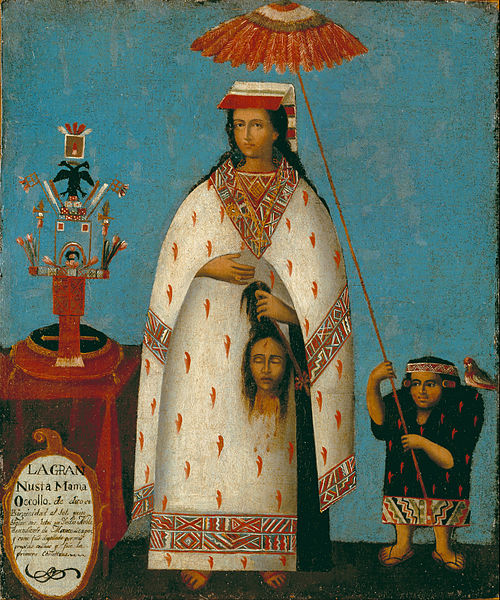 Inca Princess - La Gran Ñusta Mama Occollo, early 1800s, Denver Art Museum, public domain, Wikimedia Commons.
Inca Princess - La Gran Ñusta Mama Occollo, early 1800s, Denver Art Museum, public domain, Wikimedia Commons. 

